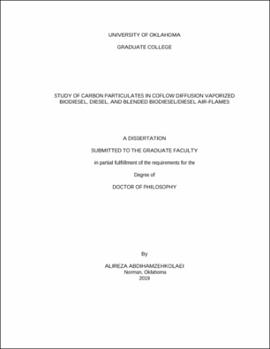| dc.description.abstract | Biodiesel, which is a biodegradable and renewable fuel, has been considered one of the best alternative fuels for diesel due to its chemical similarity. Compared to diesel, burning biodiesel will reduce various emissions such as particulate matter, unburned hydrocarbons, carbon monoxide, and carbon dioxide which are well-known harmful components for the environment and human health. Employment of biodiesel/diesel blends is very common as well, especially in compression-ignition (CI) engines, as allows to lessen the difficulties of using pure biodiesel and help reducing the final fuel price. Therefore, studying the impact of biodiesel on combustion emissions is of great interest and was the main motivation for the current study. Despite the established findings on biodiesel, still there is not a clear understanding of how particulate matter forms and oxidizes during the combustion of this renewable fuel. In this experimental study, a detailed evolution process of carbon particulate formation along the axial direction of various co-flow diffusion air flames is presented. The studied flames are formed by three popular biodiesels (canola methyl ester (CME), cotton methyl ester (COME), and soy methyl ester (SME)), #2 diesel, and diesel/CME blending. Soot samples were collected directly from inside of the flame volume using the thermophoretic sampling technique which employs the temperature gradient to capture particles from specific flame positions. Transmission electron microscopy (TEM) follows the sample extraction to analyze and obtain the desired properties. The obtained evolution process provides information of particle size, liquid-like and droplet-like characteristics, fractal dimension, radius of gyration, number of primary particles per aggregates, and nanostructure of soot samples extracted from studied flames. A typical soot formation and oxidation behavior was detected inside all tested flames. However, unique structures resembling tar-like material with droplet-like characteristic were dominant inside the evaporated biodiesel and blended fuel flames. Physical properties of soot aggregates (such as fractal dimension (Df), degree of branching, aggregates skeleton and branching length) were calculated from their two-dimension projections (TEM images). Fractal analysis of TEM images aids in quantifying morphologic variations of fractal aggregates and correlating them to growth and evolution mechanism. Outside the soot inception region, distinct fractal-like morphologies were detected between biodiesel and diesel. The calculation resulted in lower Df values for aggregates generated by the tested biodiesels and blended mixtures compared to diesel indicating more open-structured soot aggregates for biodiesel and blending and more compact aggregates for diesel. However, since Df values cannot solely explain the considerable difference observed between soot clusters produced by various tested fuels, the branching and skeleton length have been employed to quantify distinguishable characteristics of soot aggregates. It was noticed that all tested biodiesels and blended mixtures formed flames containing soot aggregates with stronger branching and longer skeleton length compared to diesel (except B20, which the number after the letter “B” represents the percentage of biodiesel in the fuel mixture). The evolution of soot aggregates is hypothesized to cause the distinct characteristics. The agglomeration and growth stages inside the biodiesels, B50, and B80 flames are observed to follow the order of soot inception, monomer-cluster aggregation, carbonization, and cluster-cluster aggregation. However, the growth process inside the diesel and B20 flames is spotted to be slightly different with carbonization proceeding the monomer-cluster aggregation. In addition to the growth process, biodiesel was found to strengthen the soot inception hence increasing the concentration of singlet particles which can enhance the branching and elongation of the agglomerates. High-resolution TEM (HR-TEM) images of selected soot particles revealed a nanostructure composed of shorter and more curved carbon layers with smaller interlayer separation in case of biodiesel and blending with respect to diesel. This observation suggests less graphitized internal structure and higher oxidative reactivity for biodiesel which is another desired characteristic in particulate filters. | en_US |
